Do you have a question about the Suzuki GSX-R1000/A and is the answer not in the manual?
Explains the meanings of WARNING, CAUTION, NOTICE, and NOTE symbols used throughout the manual.
Provides guidelines for installing accessories and safe motorcycle loading limits to maintain stability.
Offers advice on wearing protective gear, riding apparel, and pre-ride inspections for rider safety.
Details the locations of the frame and engine serial numbers for registration and parts ordering.
Illustrates and identifies key components and controls on the motorcycle's handlebars and body.
Explains the functions of the ignition switch positions: OFF, ON, LOCK, and P (Parking).
Details the various indicators, gauges, and displays on the instrument panel and their meanings.
Describes the clutch lever, dimmer switch, headlight flasher, and hazard warning switch.
Details the engine stop switch, front brake lever, electric starter, and throttle grip.
Explains how to operate the gearshift lever and the rear brake pedal for proper shifting and braking.
Provides instructions for removing and reinstalling the front and rear seats and using helmet holders.
Guides on adjusting front and rear suspension spring pre-load and damping force for optimal ride comfort.
Specifies the recommended unleaded gasoline octane rating and guidelines for using oxygenated fuels.
Details recommended engine oil types, SAE viscosity, API and JASO classifications for optimal engine performance.
Advises on the type of engine coolant to use and proper mixing ratios with distilled water for optimal cooling.
Outlines maximum engine speed recommendations and best practices for varying engine speed during break-in.
Explains the necessary break-in procedure for new tires to ensure maximum performance and safety.
Emphasizes the importance of the initial service and performing pre-ride inspections for safe operation.
Guides on safely starting the engine under various conditions and smoothly moving the motorcycle from a stop.
Details the shifting schedule and proper techniques for upshifting and downshifting for optimal performance.
Explains how to safely stop the motorcycle, including ABS operation, and proper parking techniques.
Provides a chart detailing intervals for inspection, service, lubrication, and replacement of key components.
Lists essential tools and indicates major lubrication points on the motorcycle for smooth operation.
Covers battery type, charging rates, safety precautions, and proper handling and disposal of batteries.
Explains how to inspect, clean, or replace the air cleaner element to maintain engine performance.
Details the procedure for removing, inspecting, and replacing spark plugs, including gap measurement.
Covers inspection of brake fluid, hoses, pads, and levers, plus fluid replacement and pedal adjustment.
Provides information on checking tire condition, pressure, loading, and replacement guidelines for safety.
Guides on the proper procedures for removing and installing the front and rear wheels, including safety precautions.
Lists bulb wattage ratings and instructions for replacing headlight, turn signal, and other lights.
Explains the location of the fuse box, spare fuses, and lists the function of each fuse in the electrical system.
Guides on diagnosing and resolving problems related to the fuel injection system, indicated by the 'FI' light.
Provides steps for checking the spark plug and ignition coil for proper spark generation.
Offers potential causes and checks for engine stalling, including fuel level, electronic system, and idle speed.
Provides instructions for preparing the motorcycle for extended periods of non-use, including fuel, engine, and battery.
Offers advice on cleaning, protecting metal surfaces, and storing the motorcycle to prevent corrosion.
Details the correct procedures for washing the motorcycle, including cleaning agents, water usage, and areas to avoid.
Recommends lubricating points and performing pre-ride checks after washing to ensure proper function.
Lists the overall dimensions, wheelbase, seat height, and curb mass of the motorcycle.
Details engine type, bore, stroke, transmission, gear ratios, and drive chain specifications.
Includes information on front and rear suspension, steering angle, caster, trail, and brake system details.
Lists ignition type, spark plug, battery, generator, fuses, and all indicator light specifications.
Specifies the fuel tank capacity, engine oil capacity, and coolant capacity.
| Brand | Suzuki |
|---|---|
| Model | GSX-R1000/A |
| Category | Motorcycle |
| Language | English |
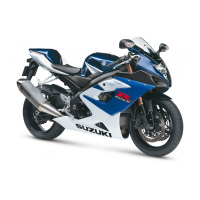
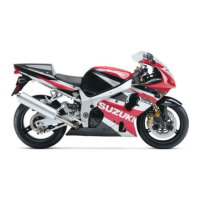
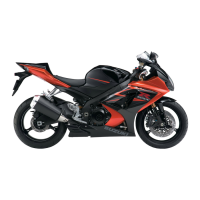
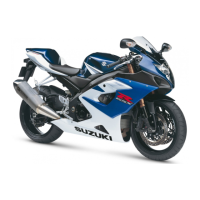
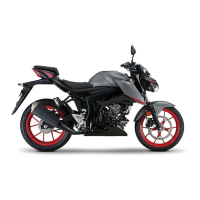
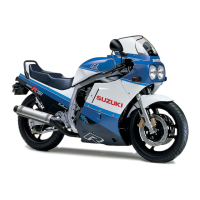

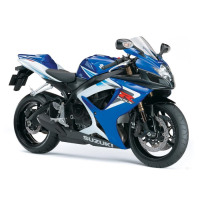

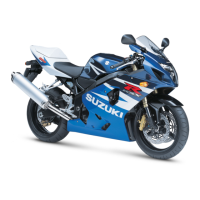
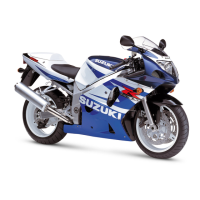
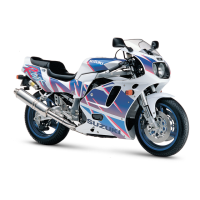
